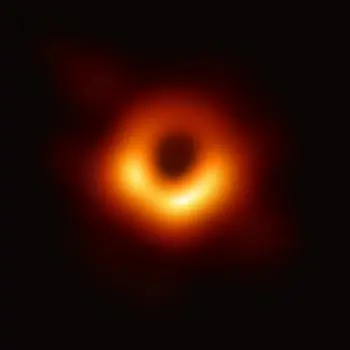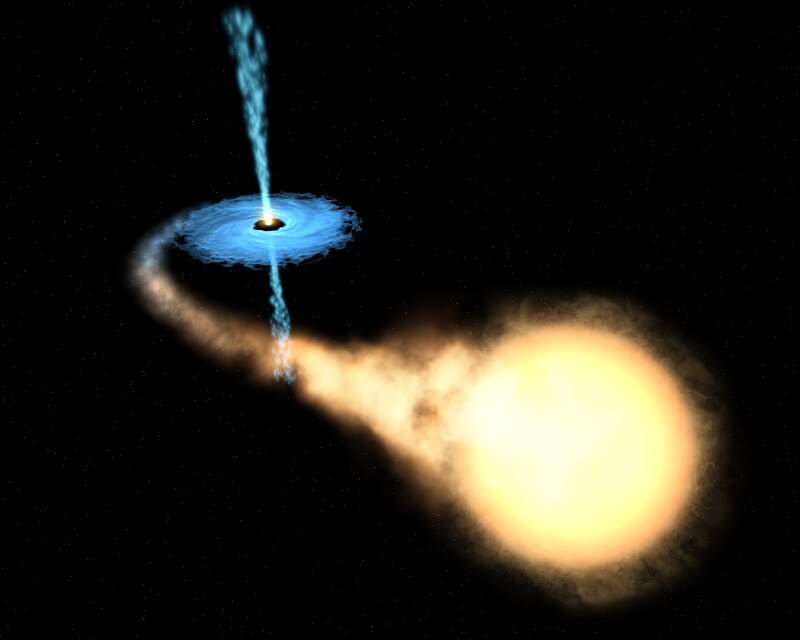
Black holes have been a topic of great interest in the field of astronomy for decades. These regions of space, where gravity is so intense that nothing can escape, represent an element of special interest to astronomers and an important link with relativistic physics.
A black hole is a region of space where gravity is so intense that nothing, not even light, can escape its pull. In essence, it is a massive concentration of matter that has collapsed in on itself, creating an extreme warp in the fabric of space-time.
The concept of a black hole is derived from Einstein's theory of general relativity, which revolutionized our understanding of gravity. According to this theory, an object's mass curves space-time around it, and gravity is simply the natural response of other objects to that curvature.
When the curvature of space-time is so deep that it creates a point of no return, known as the "event horizon," a black hole forms.
Types of black holes
Black holes can be classified into three main categories:
Stellar
 These holes form from the collapse of massive stars. When a star exhausts its nuclear fuel, gravity becomes the dominant force, and the star collapses under its own weight.
These holes form from the collapse of massive stars. When a star exhausts its nuclear fuel, gravity becomes the dominant force, and the star collapses under its own weight.
If the star is massive enough, it can become a stellar black hole.
These black holes have masses ranging from a few times the mass of our sun to dozens of times the solar mass.
Supermassive
These are much larger than stellar ones and can have masses equivalent to millions or even billions of times the mass of the sun.
They are found at the center of most galaxies, including our own, the Milky Way.
The formation of supermassive black holes remains a mystery, but they are believed to develop over eons, accreting matter from their surroundings.
Primordial
Unlike the previous two types, primordial ones formed in the early stages of the universe, shortly after the Big Bang.
They are theorized to be the result of small density fluctuations that collapsed into black holes. Their mass varies widely, from small fractions of the Earth's mass to thousands of solar masses.
Black holes and the theory of relativity
Einstein's theory of general relativity provides the theoretical basis for the existence of black holes and describes how they work.
In 2019, the Event Horizon Telescope (EHT) achieved a historic milestone by capturing the first image of a black hole at the center of the M87 galaxy. This monumental feat not only confirmed the existence of black holes, but also demonstrated the accuracy of relativistic physics under extreme conditions.
Here are some key concepts from relativistic physics that are related to black holes:
Curvature of Space-Time
The theory of general relativity postulates that gravity is not a mysterious force that acts at a distance, as was thought in Newtonian theory.
Instead, gravity is due to the curvature of space-time caused by the presence of mass and energy. Black holes are the extreme result of this curvature, where space-time bends so intensely that it forms a bottomless pit.
event horizon
The event horizon is an imaginary boundary around a black hole. When something crosses this horizon, it can no longer escape the black hole's gravity.
Even light, traveling at the maximum speed allowed in the universe , cannot escape the event horizon, giving black holes their characteristic "black" appearance.
Relativity and time distortion
General relativity predicts that time and space become distorted near massive objects. This gives rise to phenomena such as time dilation, where time passes more slowly in strong gravity.
Near a black hole, this time dilation becomes extreme, meaning that time passes more slowly for a distant observer compared to someone approaching the black hole.
Gravitational lens effect
Black holes can also act as gravitational lenses, bending light from objects behind them and creating visual distortion effects.
This has allowed astronomers to detect invisible black holes indirectly by observing their influence on the light of distant stars and galaxies.
Black holes in our galaxy
Our Milky Way galaxy is home to several known black holes that can be classified into two main categories: stellar and supermassive.
Some of the most notable in the Milky Way are the following:
- A0620-00 (V616 Monocerotis) : This is a binary stellar black hole located in the Monoceros constellation. It is approximately 6 to 12 times the mass of our Sun and forms a binary system with a companion star. It was one of the first observed stellar black holes.
- Cygnus X-1 : Located in the Cygnus constellation, Cygnus X-1 is one of the most famous stellar black holes. It has a mass of about 15 times the solar mass and forms a binary system with a blue supergiant star called HDE 226868.
- GS 2000+25 : This stellar black hole is located in the Pegasus constellation. Its mass is estimated to be approximately 7.5 solar masses, and it is part of a binary system with a companion star.
- Sagittarius A (Sgr A) : At the center of the Milky Way, there is a supermassive black hole called Sagittarius A. It has a mass equivalent to approximately 4 million times the mass of our Sun. Although it is one of the closest supermassive black holes , is difficult to observe directly due to its location in the galactic center and the presence of a large amount of interstellar dust and gas.
- Black hole at the center of galaxy M87 : Although M87 is a giant elliptical galaxy that is not part of the Milky Way, it is known to host one of the most massive supermassive black holes ever observed. This black hole has a mass of approximately 6.5 billion times the mass of the Sun and is located at the center of the galaxy M87, which is about 53 million light years away from us.
Observation techniques
Black holes are extremely dense objects that do not emit light themselves, making direct observation difficult. However, they can be detected in various ways:
- Observation of effects on nearby objects: Its presence can be detected by observing how it affects nearby objects, such as stars or gas. For example, if a star is orbiting an invisible but very massive object, changes in its speed or in the light it emits can be observed, suggesting the presence of a black hole.
- Emission of electromagnetic radiation: Although they do not emit light directly, the material around them can emit radiation at different wavelengths. This includes radiation emitted by the accretion of material in the surrounding accretion disk, as well as radiation generated by particle jets that are ejected from the poles of the black hole.
- Radio interferometry: This technique combines signals from multiple telescopes to create a detailed image of the region around you. The Event Horizon Telescope (EHT) used radio interferometry to capture the first direct image of a black hole in 2019.
Discoverer
The theoretical existence of black holes dates back to the early 20th century, but it was physicist Karl Schwarzschild who, in 1916, developed the first exact solutions to Einstein's field equations that describe these objects in general relativity. Later, in 1939, J. Robert Oppenheimer and his student Hartland Snyder theoretically demonstrated that a massive star that exhausted its nuclear fuel could collapse under the influence of its own gravity to form a black hole.
However, direct observation of black holes came decades later, with the historic capture of the first image of one in 2019, thanks to the Event Horizon Telescope, a collective achievement of numerous scientists and international collaborators.


